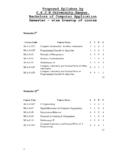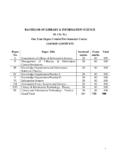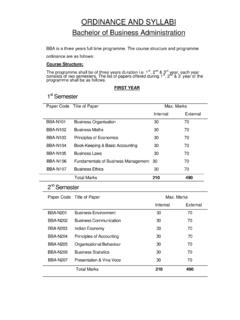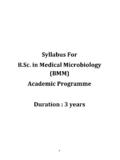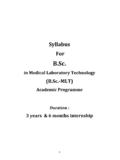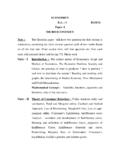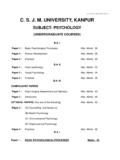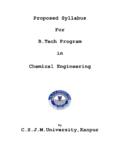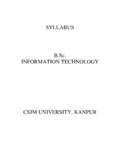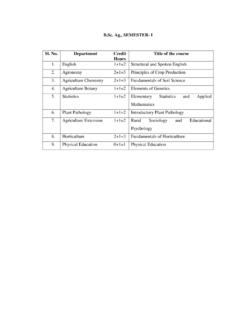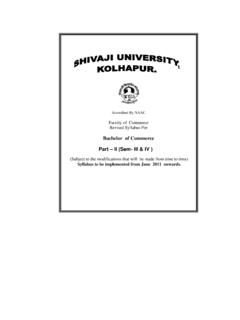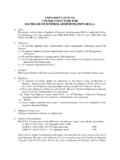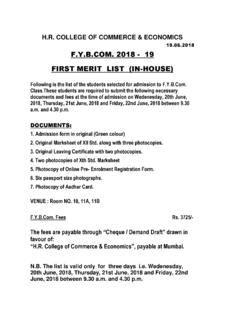Transcription of BACHELOR OF COMMERCE (B.COM-I)
1 BACHELOR OF COMMERCE ( ). COURSE INPUT DETAILS. GROUP-A: PAPER-I BUSINESS COMMUNICATION. OBJECTIVE. The objective of this course is to develop effective business communication skills among the students. COURSE INPUTS. UNIT I Introducing Business Communication: Basic forms of communicating;. Communication models and processes; Effective communication; Theories of communication; Audience analysis. UNIT II Self-Development and Communication Development of positive personal attitude; SWOT analysis; Vote's model of interdependence; Whole communication. UNIT III Corporate Communication: Formal and informal communication networks.
2 Grapevine; Miscommunication (Barriers); Improving communication. Practices <<in business communication; Group discussions; Mock interviews;. Seminars; Effective listening exercises; Individual and group presentations and reports writing. UNIT IV Principles of Effective Communication. UNIT V Writing Skills; Planning business messages; Rewriting and editing; The first draft; Reconstructing the final draft; Business letters and memo formats;. Appearance request letters; Good news and bad news letters; Persuasive letters;. Sales letters; Collection letters; Office memorandum. UNIT VI Report Writing: Introduction to a proposal, short report and formal report, report preparation.
3 Oral Presentation: Principles of oral presentation, factors affecting presentation, sales presentation, training presentation, conducting surveys, speeches to motivate, effective presentation skills. UNIT VII Non-Verbal Aspects to Communicating. Body language: Kinesics, Proxemics, Para language. Effective listening: Principles of effective listening; Factors affecting listening exercises; Oral, written, and video sessions. Interviewing Skills: Appearing in interviews; Conducting interviews; Writing resume and letter of application. Modern Forms of Communicating: Fax; E-mail: Video conferencing etc.
4 International Communication: Cultural sensitiveness and cultural context. Writing and presenting in international situations; Inter-cultural factors in interactions; Adapting to global business. Suggested Readings 1. Bovee and Thill: Business Communication Today; Tata McGraw Hill, New Delhi. 2. Ronald E. Dulek and John : Principles of Business Communication; Macmitlan Publishing Company London. 3. Randall ; Business Communication: Harper and Raw New York. 4. Webster's Guide to Effective Letter Writing; Harper and Row, New York. 5. Balasubramanyam; Business Communications; Vikas Publishing House, Delhi.
5 6. Kaul: Business Communication; Prentice Hall, New Delhi. 7. Kaul: Effective Business Communication: Prentice Hall, New Delhi. 8. Patri VR: Essentials of Communication; Greenspan Publications, New Delhi. 9. Senguin J: Business Communication; The Real World and Your Career, Allied Publishers, New Delhi. 10. Robinson, Netrakanti and Shintre: Communicative Competence in Business English; Orient Longman, Hyderabad. GROUP-A: PAPER-II BUSINESS STATISTICS. OBJECTIVE. The purpose of this paper is to includes and analytical ability among the students. COURSE INPUTS. UNIT I INTRODUCTORY: Meaning, Scope, Importance and Limitations of Statistics.
6 UNIT II STATISTICALLY ENVESTIGATION: Planning of statistical investigation, census and sampling methods Collection of Collection of primary and Secondary data, Statistical errors and approximation, classification and Tabulation of data, Frequency distribution. UNIT III DIAGRAMMATIC AND GRAPHIC PRESENTATION: One Dimensional. Two dimensional Diagrams Histogram, Historigram, Frequency polygon. Frequency curve and Ogive curves. Graphs and Natural and semi-Logarithmic scales Graphic location of mode Median and quartiles. UNIT IV STATISTICAL AVERAGE: Arithmetic, geometric and Harmonic means, Mode Median, Qualities and percentiles, Simple and weighted averages.
7 Uses and Limitations of different averages. UNIT V DISPERSION AND SKEWNESS: Range, Quartile deviation, mean Deviation and their coefficients, Standards deviation, coefficient of variation, Skewness and its coefficients. UNIT VI CORRELATION: Kari person's coefficient of correlation, Probable Error and interpretation of coefficient of correlation, Rank Difference Method and Concurrent Deviation method. Linear Regression. UNIT VII Interpolation & Extrapolation or Forecasting: Newton's Advance difference, Lagranges Formula, Parabolic Curve Method, Binomial Expansion Method, Theory of Probability (Simple Problems).
8 UNIT VIII INDEX NUMBERS: Utility of index numbers. Problems in the construction of index numbers, simple and weighted index number, Base shifting fishers ideal index number and tests of Reversibility. UNIT IX INDIAN STATISTIC: Census Price, Agriculture and industrial statistics. Suggested Readings: 1. Elhance, Fundamentals of Statistics. 2. Singh, lkaf[;dh ds fl)kUrA. 3. Nagar, lkaf[;dh ds fl)kUrA. 4. Hooda, Statistics for business and Economics. 5. Gupta, Fundamentals of Statistics. 6. Lewin and Rubin, Statistics for Management. 7. Tondan, Ravi: Business Statistics. GROUP-B: PAPER-III FINANCIAL ACCOUNTING.]]
9 OBJECTIVE. To Impart accounting knowledge as applicable to business. COURSE INPUTS. UNIT I Meaning and Scope of Accounting Need, development, and definition of accounting; Book-keeping and accounting; Persons interested in accounting;. Disclosures; Branches of accounting; Objectives of accounting. Capital &. Revenue classification of Income, Expenditure & Receipts. UNIT II Accounting Principles: International accounting standards (only outlines);. Accounting principles: Accounting standards in India. Accounting Transactions: Accounting Cycle, Journal; Rules of debit and credit; Compound journal entry; Opening entry; Relationship between journal and ledger, Rules regarding posting; Trial balance; Sub division of journal.
10 UNIT III Final accounts; Manufacturing account; Trading account; Profit and loss account; Balance Sheet; Adjustment entries. UNIT IV Insolvency accounts- Individual a& partnership firm & Computation of Insurance claims (General Insurance). UNIV V Branch Accounts: Dependent branch; Debtors system, stock and debtor system. Final Accounts System; Wholesale branch; Independent branch;. Foreign branch;. UNIT VI Hire-purchase and installment purchase system; Meaning of hire-purchase contract; Legal provision regarding hire-purchase contract; Accounting records for goods of substantial sale values, and accounting records for goods of small values; Installment purchase system; After sales service.
